MIS605 - Analysis and Design of Online Enrolment System Report
VerifiedAdded on 2022/08/21
|12
|2719
|23
Report
AI Summary
This report presents an analysis and design for an online student enrolment system, addressing the needs of ABC University. It begins by defining stakeholders and actors, then outlines the functional requirements, such as student enrollment, subject selection, and payment processing, along with non-functional requirements including privacy, security, and user-friendliness. The report incorporates a UML use case diagram to visually represent system functionalities, including student, admin, and lecturer interactions. Furthermore, it details two key use cases: 'Register' and 'Payment,' providing step-by-step descriptions, preconditions, normal and alternative courses, postconditions, and potential exceptions. The student enrolment system aims to replace the manual system and streamline the enrollment process for students.
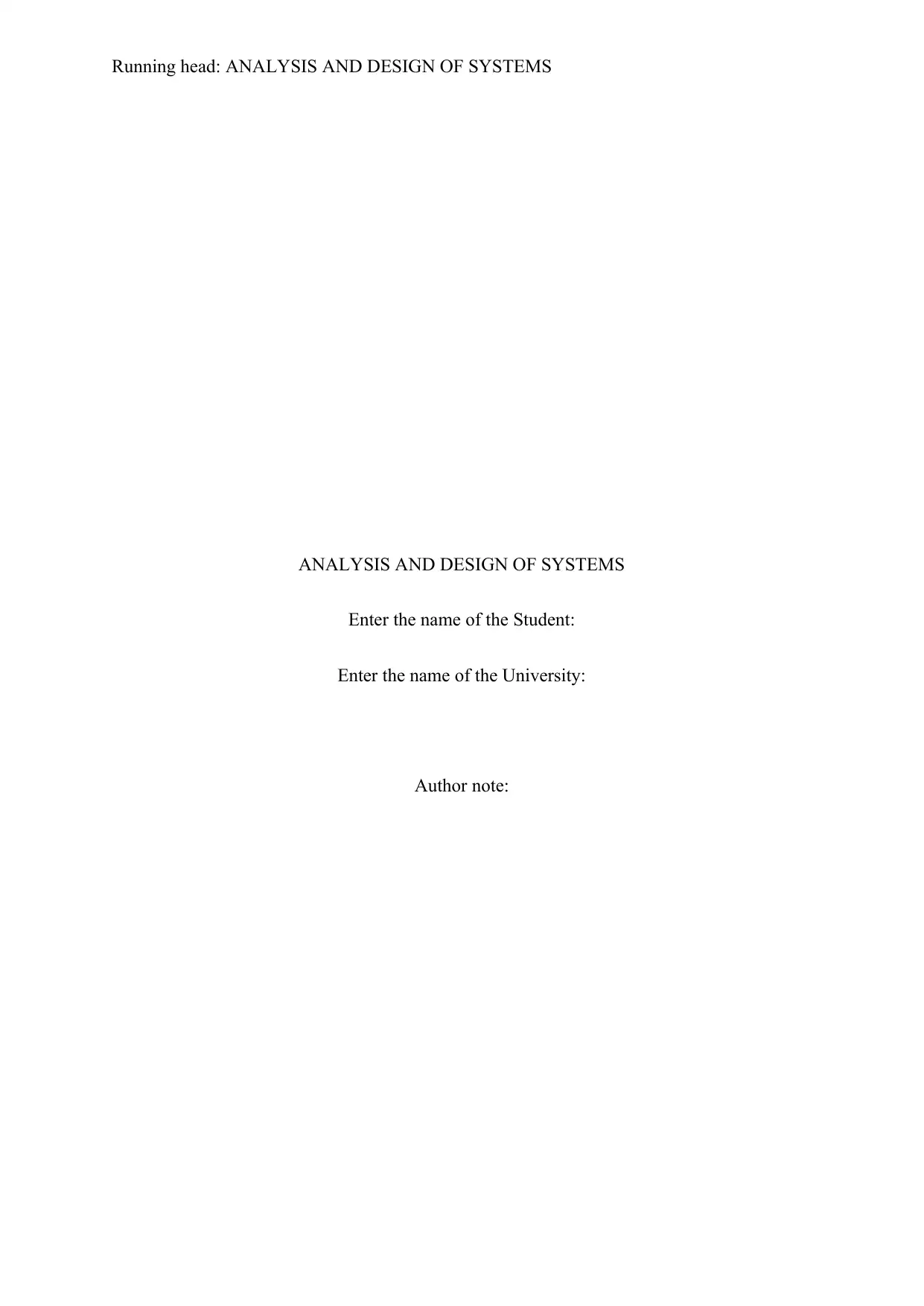
Running head: ANALYSIS AND DESIGN OF SYSTEMS
ANALYSIS AND DESIGN OF SYSTEMS
Enter the name of the Student:
Enter the name of the University:
Author note:
ANALYSIS AND DESIGN OF SYSTEMS
Enter the name of the Student:
Enter the name of the University:
Author note:
Paraphrase This Document
Need a fresh take? Get an instant paraphrase of this document with our AI Paraphraser
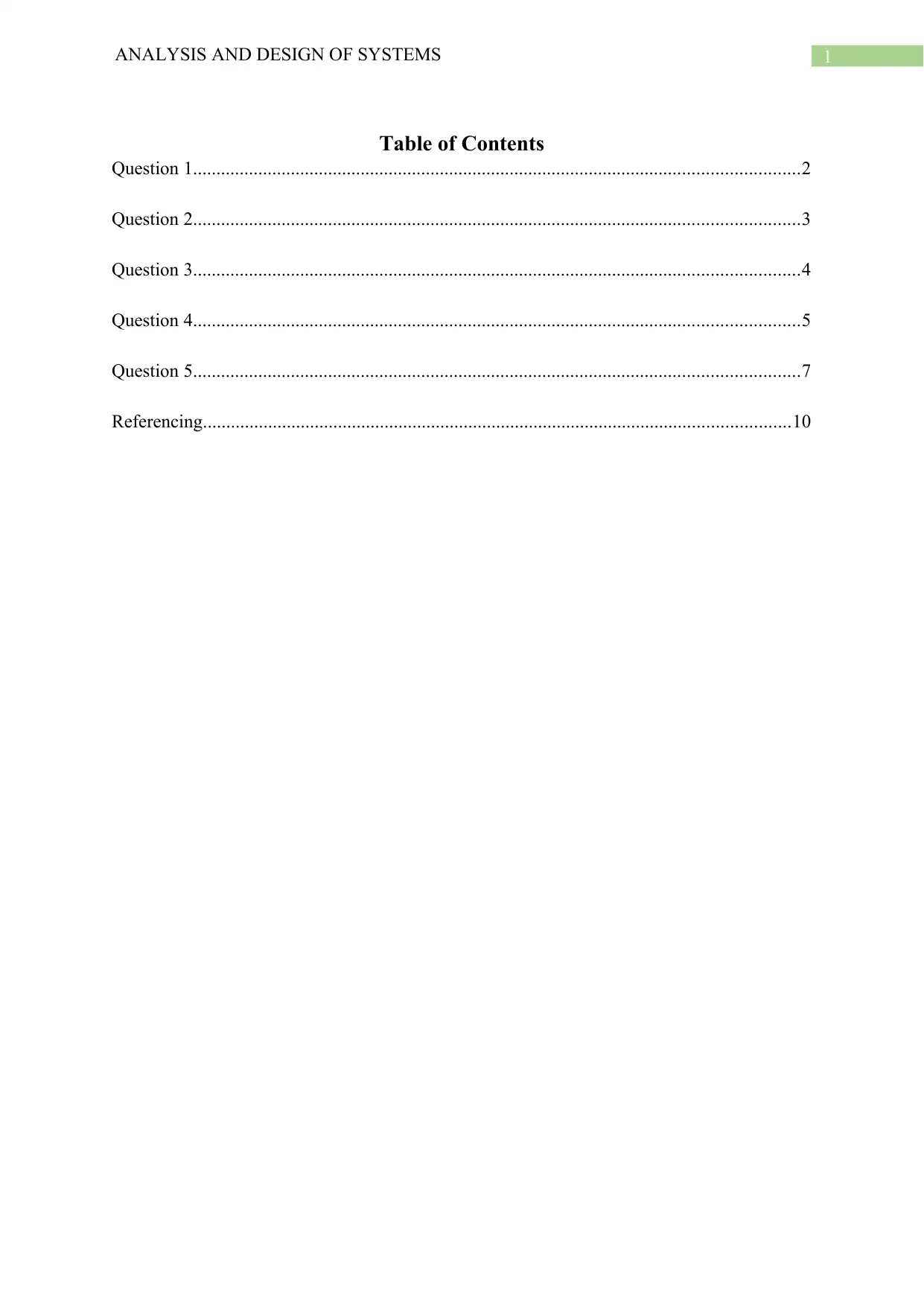
1ANALYSIS AND DESIGN OF SYSTEMS
Table of Contents
Question 1..................................................................................................................................2
Question 2..................................................................................................................................3
Question 3..................................................................................................................................4
Question 4..................................................................................................................................5
Question 5..................................................................................................................................7
Referencing..............................................................................................................................10
Table of Contents
Question 1..................................................................................................................................2
Question 2..................................................................................................................................3
Question 3..................................................................................................................................4
Question 4..................................................................................................................................5
Question 5..................................................................................................................................7
Referencing..............................................................................................................................10
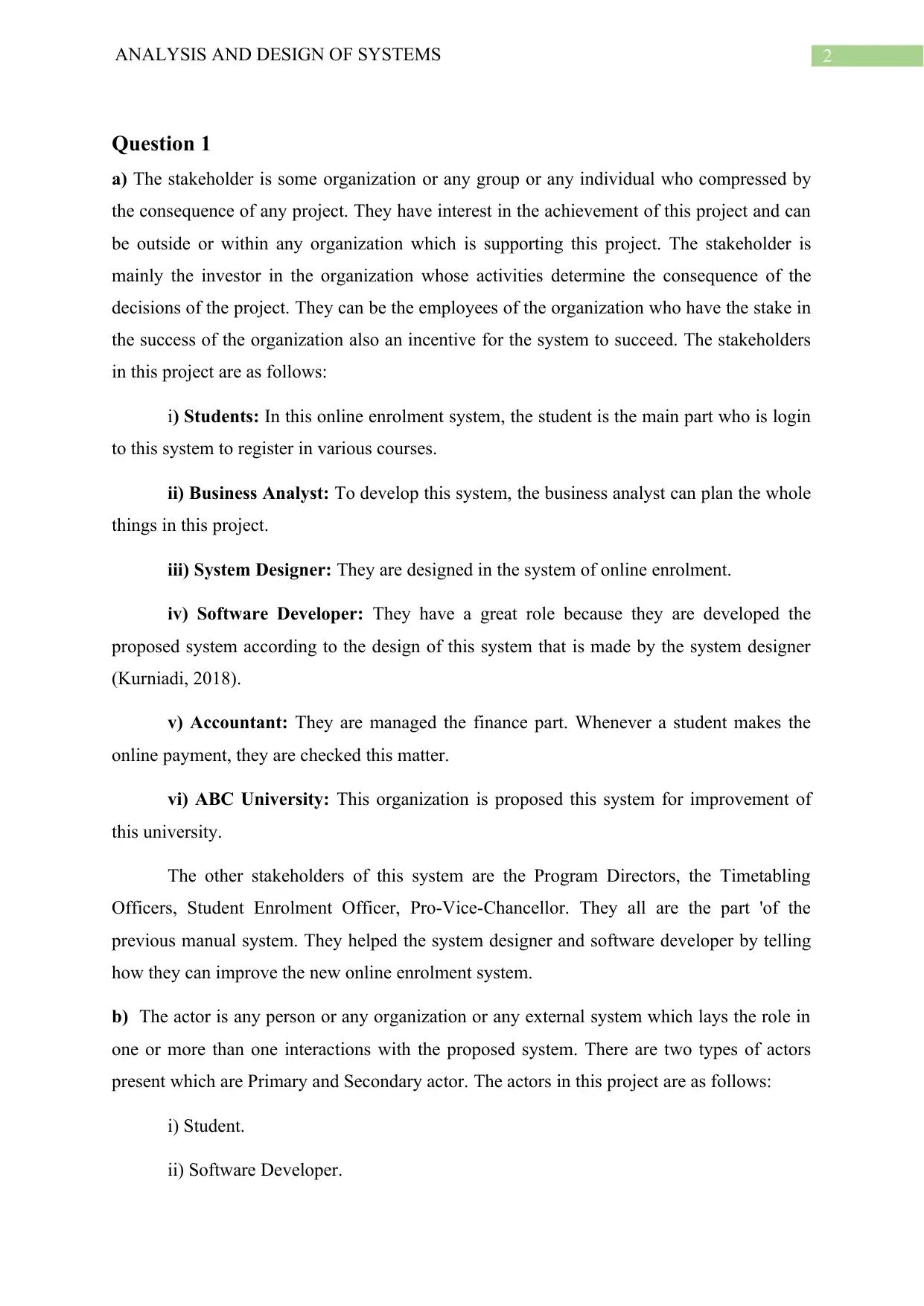
2ANALYSIS AND DESIGN OF SYSTEMS
Question 1
a) The stakeholder is some organization or any group or any individual who compressed by
the consequence of any project. They have interest in the achievement of this project and can
be outside or within any organization which is supporting this project. The stakeholder is
mainly the investor in the organization whose activities determine the consequence of the
decisions of the project. They can be the employees of the organization who have the stake in
the success of the organization also an incentive for the system to succeed. The stakeholders
in this project are as follows:
i) Students: In this online enrolment system, the student is the main part who is login
to this system to register in various courses.
ii) Business Analyst: To develop this system, the business analyst can plan the whole
things in this project.
iii) System Designer: They are designed in the system of online enrolment.
iv) Software Developer: They have a great role because they are developed the
proposed system according to the design of this system that is made by the system designer
(Kurniadi, 2018).
v) Accountant: They are managed the finance part. Whenever a student makes the
online payment, they are checked this matter.
vi) ABC University: This organization is proposed this system for improvement of
this university.
The other stakeholders of this system are the Program Directors, the Timetabling
Officers, Student Enrolment Officer, Pro-Vice-Chancellor. They all are the part 'of the
previous manual system. They helped the system designer and software developer by telling
how they can improve the new online enrolment system.
b) The actor is any person or any organization or any external system which lays the role in
one or more than one interactions with the proposed system. There are two types of actors
present which are Primary and Secondary actor. The actors in this project are as follows:
i) Student.
ii) Software Developer.
Question 1
a) The stakeholder is some organization or any group or any individual who compressed by
the consequence of any project. They have interest in the achievement of this project and can
be outside or within any organization which is supporting this project. The stakeholder is
mainly the investor in the organization whose activities determine the consequence of the
decisions of the project. They can be the employees of the organization who have the stake in
the success of the organization also an incentive for the system to succeed. The stakeholders
in this project are as follows:
i) Students: In this online enrolment system, the student is the main part who is login
to this system to register in various courses.
ii) Business Analyst: To develop this system, the business analyst can plan the whole
things in this project.
iii) System Designer: They are designed in the system of online enrolment.
iv) Software Developer: They have a great role because they are developed the
proposed system according to the design of this system that is made by the system designer
(Kurniadi, 2018).
v) Accountant: They are managed the finance part. Whenever a student makes the
online payment, they are checked this matter.
vi) ABC University: This organization is proposed this system for improvement of
this university.
The other stakeholders of this system are the Program Directors, the Timetabling
Officers, Student Enrolment Officer, Pro-Vice-Chancellor. They all are the part 'of the
previous manual system. They helped the system designer and software developer by telling
how they can improve the new online enrolment system.
b) The actor is any person or any organization or any external system which lays the role in
one or more than one interactions with the proposed system. There are two types of actors
present which are Primary and Secondary actor. The actors in this project are as follows:
i) Student.
ii) Software Developer.
⊘ This is a preview!⊘
Do you want full access?
Subscribe today to unlock all pages.

Trusted by 1+ million students worldwide
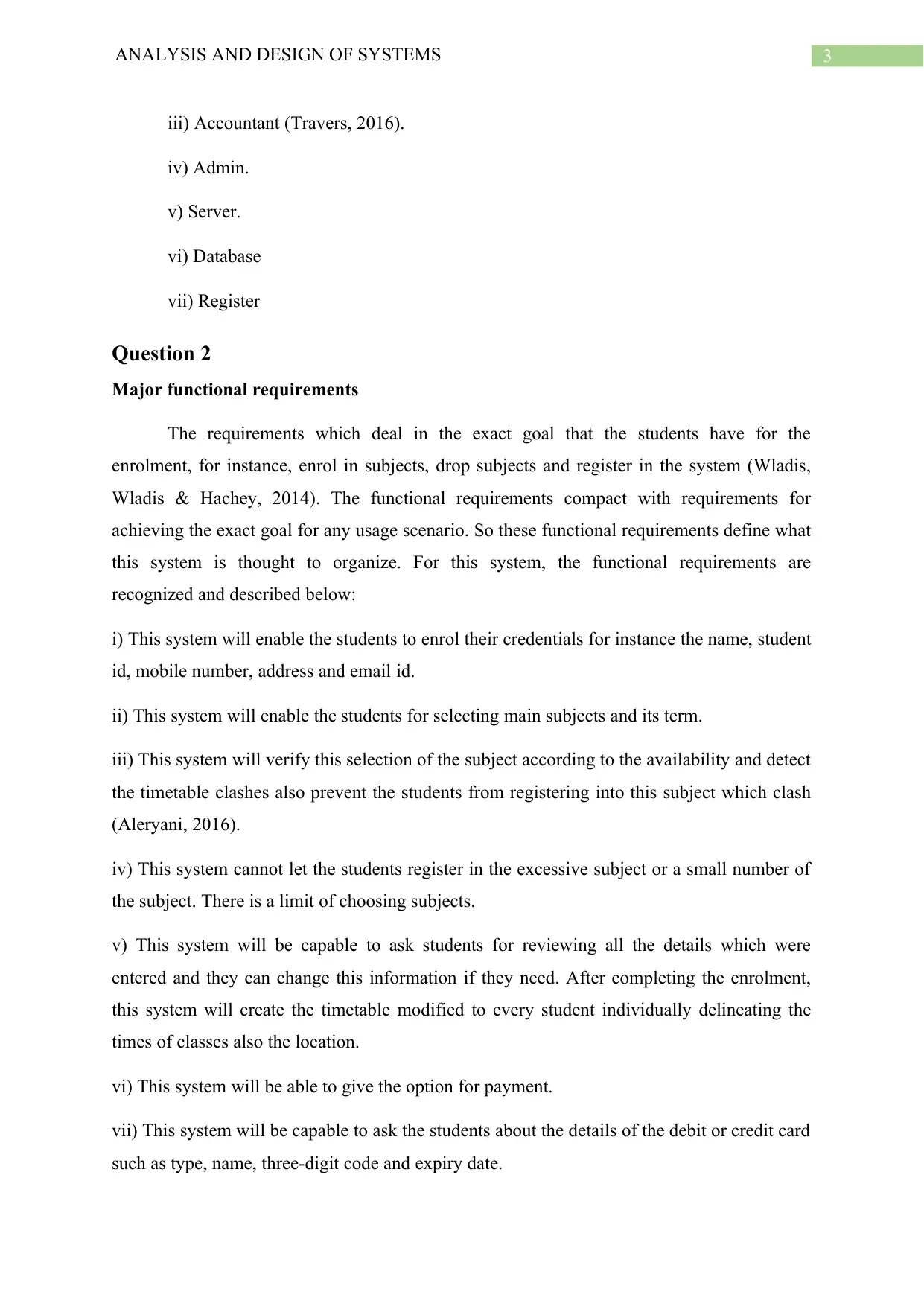
3ANALYSIS AND DESIGN OF SYSTEMS
iii) Accountant (Travers, 2016).
iv) Admin.
v) Server.
vi) Database
vii) Register
Question 2
Major functional requirements
The requirements which deal in the exact goal that the students have for the
enrolment, for instance, enrol in subjects, drop subjects and register in the system (Wladis,
Wladis & Hachey, 2014). The functional requirements compact with requirements for
achieving the exact goal for any usage scenario. So these functional requirements define what
this system is thought to organize. For this system, the functional requirements are
recognized and described below:
i) This system will enable the students to enrol their credentials for instance the name, student
id, mobile number, address and email id.
ii) This system will enable the students for selecting main subjects and its term.
iii) This system will verify this selection of the subject according to the availability and detect
the timetable clashes also prevent the students from registering into this subject which clash
(Aleryani, 2016).
iv) This system cannot let the students register in the excessive subject or a small number of
the subject. There is a limit of choosing subjects.
v) This system will be capable to ask students for reviewing all the details which were
entered and they can change this information if they need. After completing the enrolment,
this system will create the timetable modified to every student individually delineating the
times of classes also the location.
vi) This system will be able to give the option for payment.
vii) This system will be capable to ask the students about the details of the debit or credit card
such as type, name, three-digit code and expiry date.
iii) Accountant (Travers, 2016).
iv) Admin.
v) Server.
vi) Database
vii) Register
Question 2
Major functional requirements
The requirements which deal in the exact goal that the students have for the
enrolment, for instance, enrol in subjects, drop subjects and register in the system (Wladis,
Wladis & Hachey, 2014). The functional requirements compact with requirements for
achieving the exact goal for any usage scenario. So these functional requirements define what
this system is thought to organize. For this system, the functional requirements are
recognized and described below:
i) This system will enable the students to enrol their credentials for instance the name, student
id, mobile number, address and email id.
ii) This system will enable the students for selecting main subjects and its term.
iii) This system will verify this selection of the subject according to the availability and detect
the timetable clashes also prevent the students from registering into this subject which clash
(Aleryani, 2016).
iv) This system cannot let the students register in the excessive subject or a small number of
the subject. There is a limit of choosing subjects.
v) This system will be capable to ask students for reviewing all the details which were
entered and they can change this information if they need. After completing the enrolment,
this system will create the timetable modified to every student individually delineating the
times of classes also the location.
vi) This system will be able to give the option for payment.
vii) This system will be capable to ask the students about the details of the debit or credit card
such as type, name, three-digit code and expiry date.
Paraphrase This Document
Need a fresh take? Get an instant paraphrase of this document with our AI Paraphraser
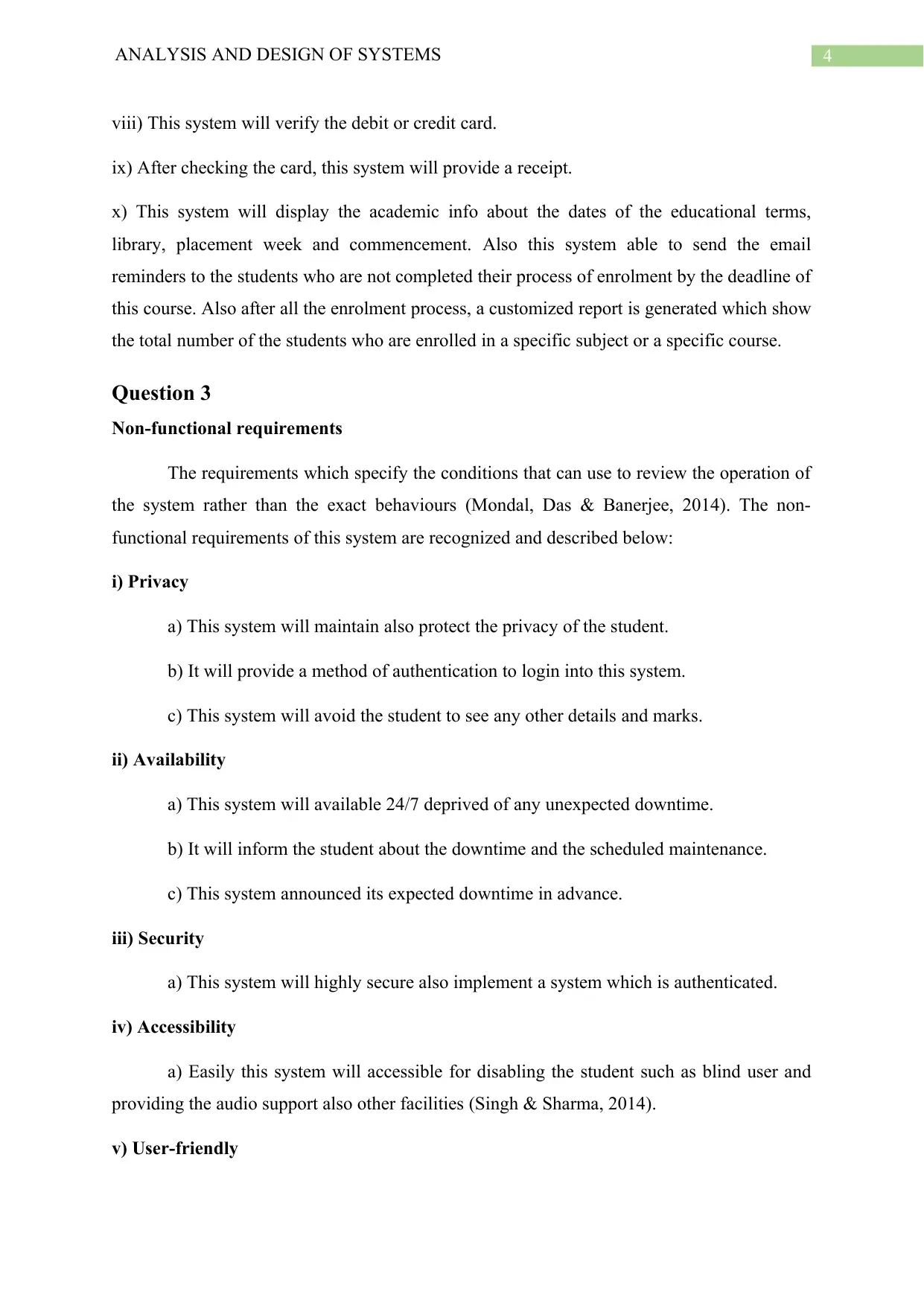
4ANALYSIS AND DESIGN OF SYSTEMS
viii) This system will verify the debit or credit card.
ix) After checking the card, this system will provide a receipt.
x) This system will display the academic info about the dates of the educational terms,
library, placement week and commencement. Also this system able to send the email
reminders to the students who are not completed their process of enrolment by the deadline of
this course. Also after all the enrolment process, a customized report is generated which show
the total number of the students who are enrolled in a specific subject or a specific course.
Question 3
Non-functional requirements
The requirements which specify the conditions that can use to review the operation of
the system rather than the exact behaviours (Mondal, Das & Banerjee, 2014). The non-
functional requirements of this system are recognized and described below:
i) Privacy
a) This system will maintain also protect the privacy of the student.
b) It will provide a method of authentication to login into this system.
c) This system will avoid the student to see any other details and marks.
ii) Availability
a) This system will available 24/7 deprived of any unexpected downtime.
b) It will inform the student about the downtime and the scheduled maintenance.
c) This system announced its expected downtime in advance.
iii) Security
a) This system will highly secure also implement a system which is authenticated.
iv) Accessibility
a) Easily this system will accessible for disabling the student such as blind user and
providing the audio support also other facilities (Singh & Sharma, 2014).
v) User-friendly
viii) This system will verify the debit or credit card.
ix) After checking the card, this system will provide a receipt.
x) This system will display the academic info about the dates of the educational terms,
library, placement week and commencement. Also this system able to send the email
reminders to the students who are not completed their process of enrolment by the deadline of
this course. Also after all the enrolment process, a customized report is generated which show
the total number of the students who are enrolled in a specific subject or a specific course.
Question 3
Non-functional requirements
The requirements which specify the conditions that can use to review the operation of
the system rather than the exact behaviours (Mondal, Das & Banerjee, 2014). The non-
functional requirements of this system are recognized and described below:
i) Privacy
a) This system will maintain also protect the privacy of the student.
b) It will provide a method of authentication to login into this system.
c) This system will avoid the student to see any other details and marks.
ii) Availability
a) This system will available 24/7 deprived of any unexpected downtime.
b) It will inform the student about the downtime and the scheduled maintenance.
c) This system announced its expected downtime in advance.
iii) Security
a) This system will highly secure also implement a system which is authenticated.
iv) Accessibility
a) Easily this system will accessible for disabling the student such as blind user and
providing the audio support also other facilities (Singh & Sharma, 2014).
v) User-friendly
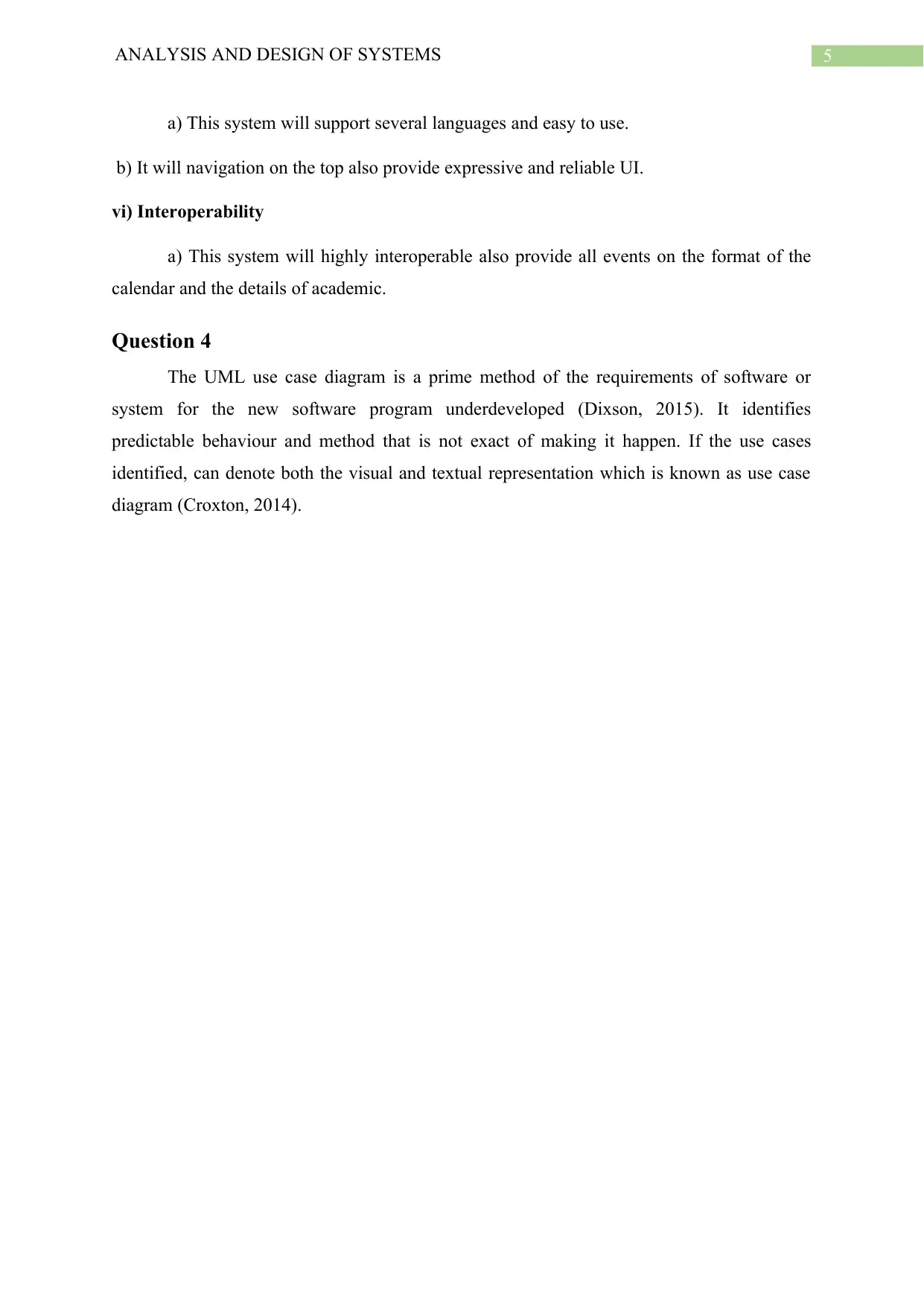
5ANALYSIS AND DESIGN OF SYSTEMS
a) This system will support several languages and easy to use.
b) It will navigation on the top also provide expressive and reliable UI.
vi) Interoperability
a) This system will highly interoperable also provide all events on the format of the
calendar and the details of academic.
Question 4
The UML use case diagram is a prime method of the requirements of software or
system for the new software program underdeveloped (Dixson, 2015). It identifies
predictable behaviour and method that is not exact of making it happen. If the use cases
identified, can denote both the visual and textual representation which is known as use case
diagram (Croxton, 2014).
a) This system will support several languages and easy to use.
b) It will navigation on the top also provide expressive and reliable UI.
vi) Interoperability
a) This system will highly interoperable also provide all events on the format of the
calendar and the details of academic.
Question 4
The UML use case diagram is a prime method of the requirements of software or
system for the new software program underdeveloped (Dixson, 2015). It identifies
predictable behaviour and method that is not exact of making it happen. If the use cases
identified, can denote both the visual and textual representation which is known as use case
diagram (Croxton, 2014).
⊘ This is a preview!⊘
Do you want full access?
Subscribe today to unlock all pages.

Trusted by 1+ million students worldwide
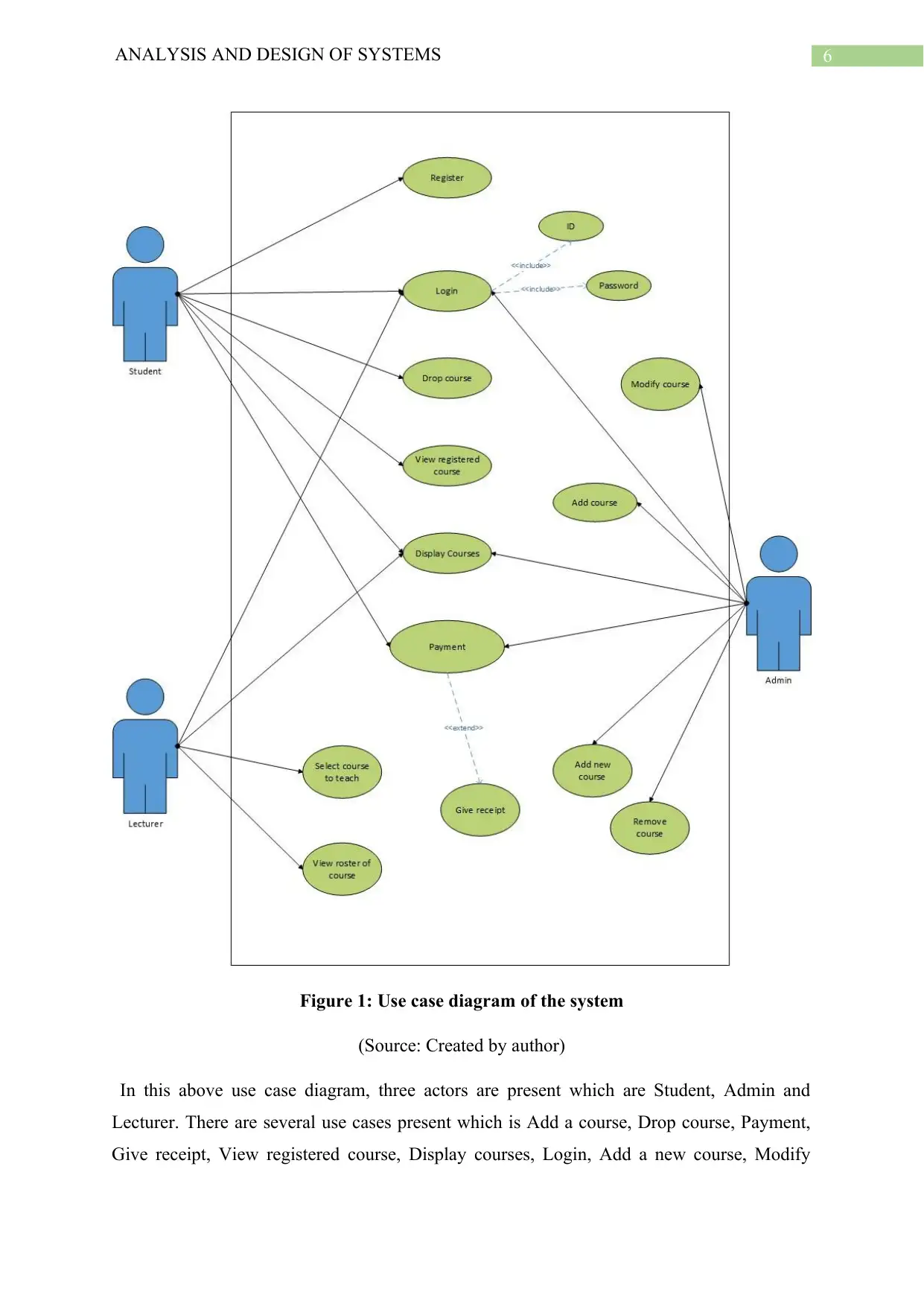
6ANALYSIS AND DESIGN OF SYSTEMS
Figure 1: Use case diagram of the system
(Source: Created by author)
In this above use case diagram, three actors are present which are Student, Admin and
Lecturer. There are several use cases present which is Add a course, Drop course, Payment,
Give receipt, View registered course, Display courses, Login, Add a new course, Modify
Figure 1: Use case diagram of the system
(Source: Created by author)
In this above use case diagram, three actors are present which are Student, Admin and
Lecturer. There are several use cases present which is Add a course, Drop course, Payment,
Give receipt, View registered course, Display courses, Login, Add a new course, Modify
Paraphrase This Document
Need a fresh take? Get an instant paraphrase of this document with our AI Paraphraser
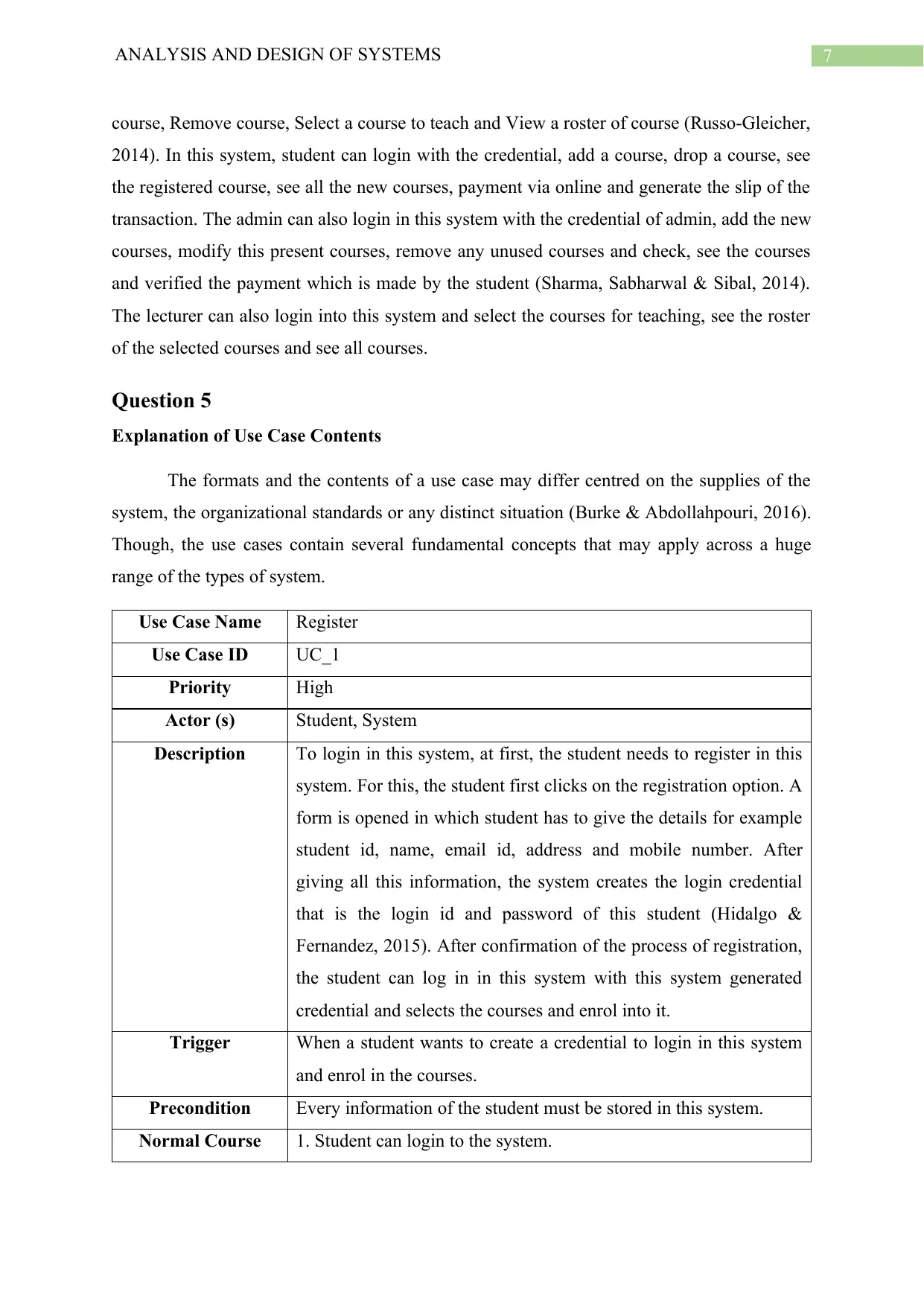
7ANALYSIS AND DESIGN OF SYSTEMS
course, Remove course, Select a course to teach and View a roster of course (Russo-Gleicher,
2014). In this system, student can login with the credential, add a course, drop a course, see
the registered course, see all the new courses, payment via online and generate the slip of the
transaction. The admin can also login in this system with the credential of admin, add the new
courses, modify this present courses, remove any unused courses and check, see the courses
and verified the payment which is made by the student (Sharma, Sabharwal & Sibal, 2014).
The lecturer can also login into this system and select the courses for teaching, see the roster
of the selected courses and see all courses.
Question 5
Explanation of Use Case Contents
The formats and the contents of a use case may differ centred on the supplies of the
system, the organizational standards or any distinct situation (Burke & Abdollahpouri, 2016).
Though, the use cases contain several fundamental concepts that may apply across a huge
range of the types of system.
Use Case Name Register
Use Case ID UC_1
Priority High
Actor (s) Student, System
Description To login in this system, at first, the student needs to register in this
system. For this, the student first clicks on the registration option. A
form is opened in which student has to give the details for example
student id, name, email id, address and mobile number. After
giving all this information, the system creates the login credential
that is the login id and password of this student (Hidalgo &
Fernandez, 2015). After confirmation of the process of registration,
the student can log in in this system with this system generated
credential and selects the courses and enrol into it.
Trigger When a student wants to create a credential to login in this system
and enrol in the courses.
Precondition Every information of the student must be stored in this system.
Normal Course 1. Student can login to the system.
course, Remove course, Select a course to teach and View a roster of course (Russo-Gleicher,
2014). In this system, student can login with the credential, add a course, drop a course, see
the registered course, see all the new courses, payment via online and generate the slip of the
transaction. The admin can also login in this system with the credential of admin, add the new
courses, modify this present courses, remove any unused courses and check, see the courses
and verified the payment which is made by the student (Sharma, Sabharwal & Sibal, 2014).
The lecturer can also login into this system and select the courses for teaching, see the roster
of the selected courses and see all courses.
Question 5
Explanation of Use Case Contents
The formats and the contents of a use case may differ centred on the supplies of the
system, the organizational standards or any distinct situation (Burke & Abdollahpouri, 2016).
Though, the use cases contain several fundamental concepts that may apply across a huge
range of the types of system.
Use Case Name Register
Use Case ID UC_1
Priority High
Actor (s) Student, System
Description To login in this system, at first, the student needs to register in this
system. For this, the student first clicks on the registration option. A
form is opened in which student has to give the details for example
student id, name, email id, address and mobile number. After
giving all this information, the system creates the login credential
that is the login id and password of this student (Hidalgo &
Fernandez, 2015). After confirmation of the process of registration,
the student can log in in this system with this system generated
credential and selects the courses and enrol into it.
Trigger When a student wants to create a credential to login in this system
and enrol in the courses.
Precondition Every information of the student must be stored in this system.
Normal Course 1. Student can login to the system.
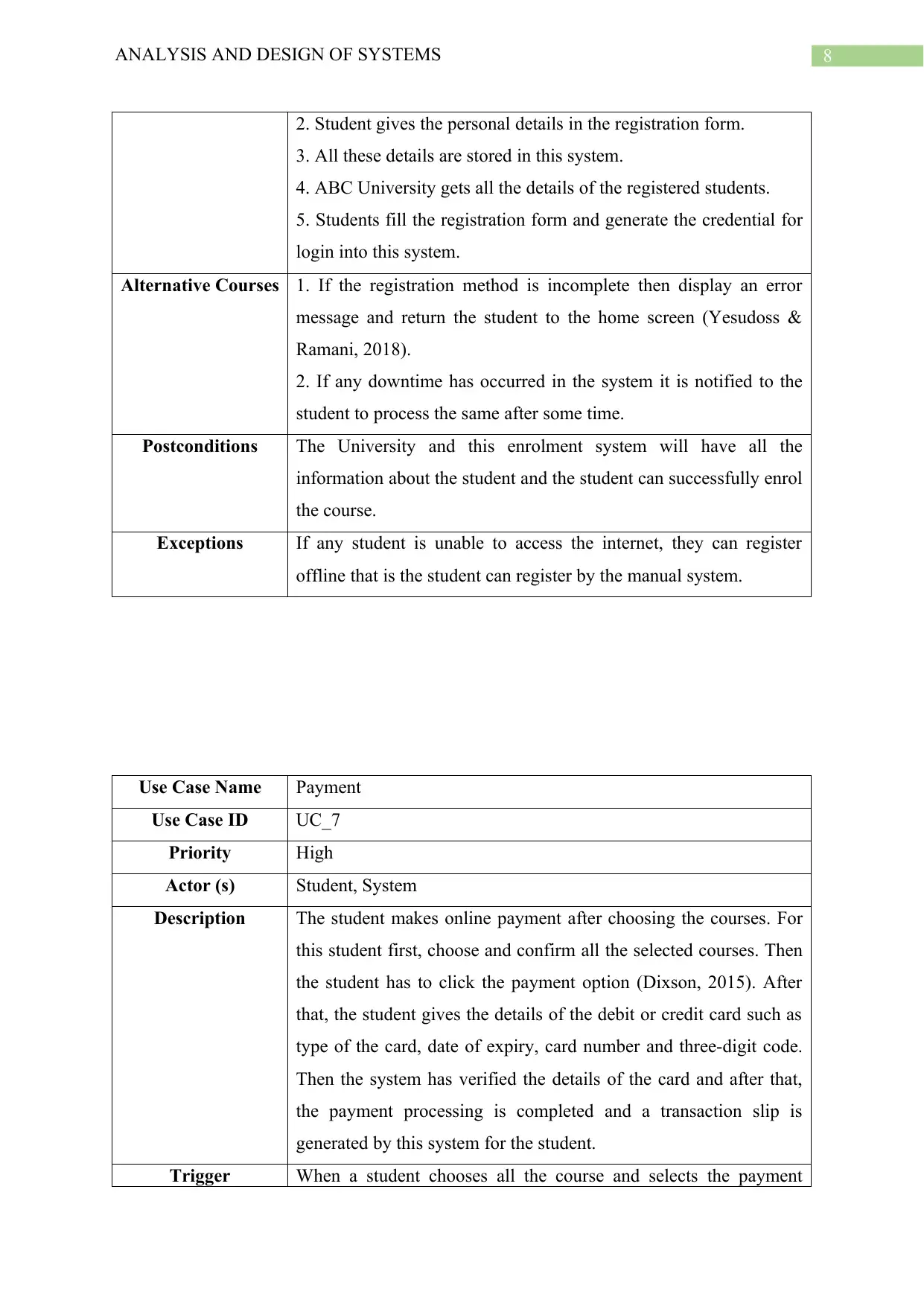
8ANALYSIS AND DESIGN OF SYSTEMS
2. Student gives the personal details in the registration form.
3. All these details are stored in this system.
4. ABC University gets all the details of the registered students.
5. Students fill the registration form and generate the credential for
login into this system.
Alternative Courses 1. If the registration method is incomplete then display an error
message and return the student to the home screen (Yesudoss &
Ramani, 2018).
2. If any downtime has occurred in the system it is notified to the
student to process the same after some time.
Postconditions The University and this enrolment system will have all the
information about the student and the student can successfully enrol
the course.
Exceptions If any student is unable to access the internet, they can register
offline that is the student can register by the manual system.
Use Case Name Payment
Use Case ID UC_7
Priority High
Actor (s) Student, System
Description The student makes online payment after choosing the courses. For
this student first, choose and confirm all the selected courses. Then
the student has to click the payment option (Dixson, 2015). After
that, the student gives the details of the debit or credit card such as
type of the card, date of expiry, card number and three-digit code.
Then the system has verified the details of the card and after that,
the payment processing is completed and a transaction slip is
generated by this system for the student.
Trigger When a student chooses all the course and selects the payment
2. Student gives the personal details in the registration form.
3. All these details are stored in this system.
4. ABC University gets all the details of the registered students.
5. Students fill the registration form and generate the credential for
login into this system.
Alternative Courses 1. If the registration method is incomplete then display an error
message and return the student to the home screen (Yesudoss &
Ramani, 2018).
2. If any downtime has occurred in the system it is notified to the
student to process the same after some time.
Postconditions The University and this enrolment system will have all the
information about the student and the student can successfully enrol
the course.
Exceptions If any student is unable to access the internet, they can register
offline that is the student can register by the manual system.
Use Case Name Payment
Use Case ID UC_7
Priority High
Actor (s) Student, System
Description The student makes online payment after choosing the courses. For
this student first, choose and confirm all the selected courses. Then
the student has to click the payment option (Dixson, 2015). After
that, the student gives the details of the debit or credit card such as
type of the card, date of expiry, card number and three-digit code.
Then the system has verified the details of the card and after that,
the payment processing is completed and a transaction slip is
generated by this system for the student.
Trigger When a student chooses all the course and selects the payment
⊘ This is a preview!⊘
Do you want full access?
Subscribe today to unlock all pages.

Trusted by 1+ million students worldwide
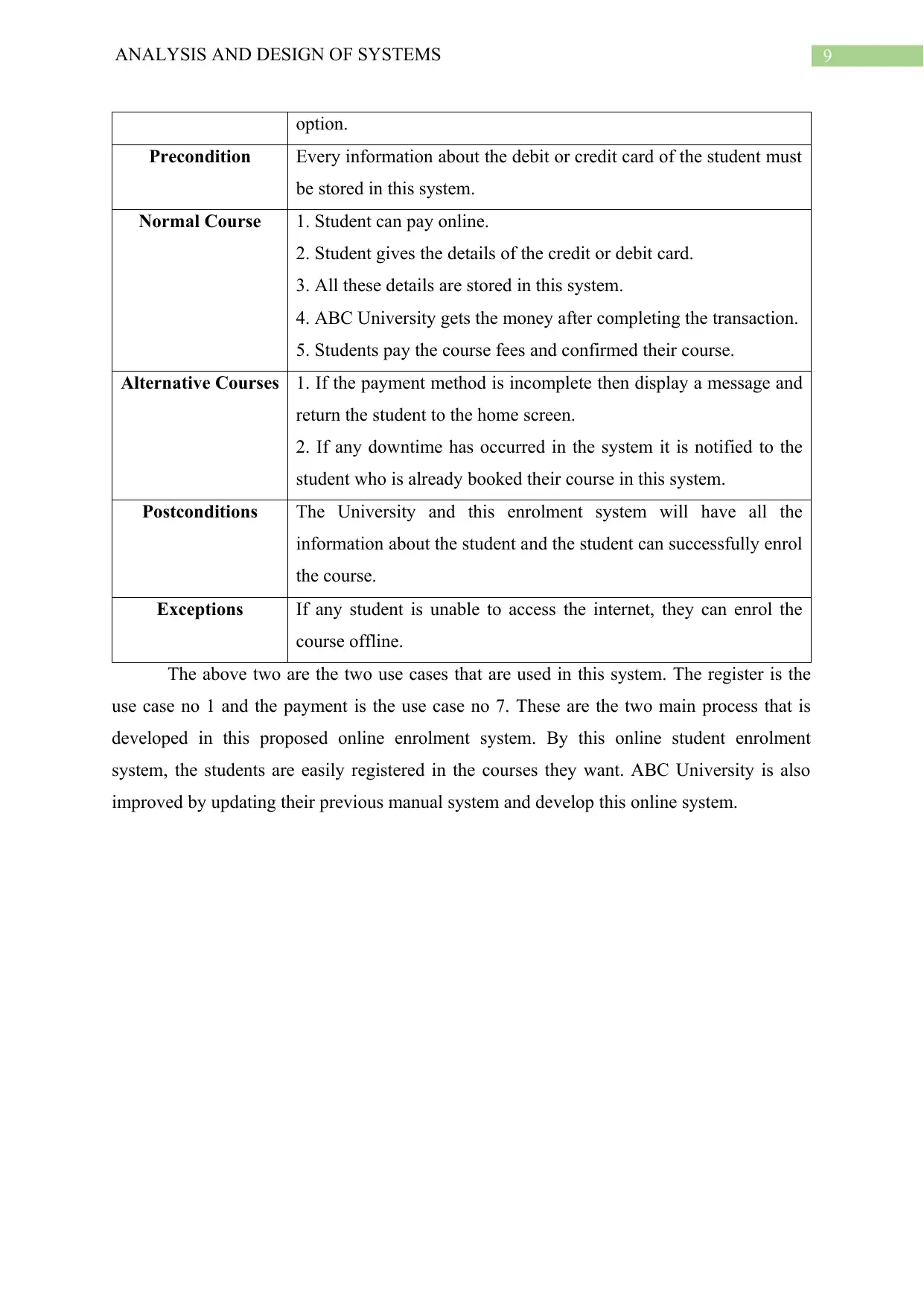
9ANALYSIS AND DESIGN OF SYSTEMS
option.
Precondition Every information about the debit or credit card of the student must
be stored in this system.
Normal Course 1. Student can pay online.
2. Student gives the details of the credit or debit card.
3. All these details are stored in this system.
4. ABC University gets the money after completing the transaction.
5. Students pay the course fees and confirmed their course.
Alternative Courses 1. If the payment method is incomplete then display a message and
return the student to the home screen.
2. If any downtime has occurred in the system it is notified to the
student who is already booked their course in this system.
Postconditions The University and this enrolment system will have all the
information about the student and the student can successfully enrol
the course.
Exceptions If any student is unable to access the internet, they can enrol the
course offline.
The above two are the two use cases that are used in this system. The register is the
use case no 1 and the payment is the use case no 7. These are the two main process that is
developed in this proposed online enrolment system. By this online student enrolment
system, the students are easily registered in the courses they want. ABC University is also
improved by updating their previous manual system and develop this online system.
option.
Precondition Every information about the debit or credit card of the student must
be stored in this system.
Normal Course 1. Student can pay online.
2. Student gives the details of the credit or debit card.
3. All these details are stored in this system.
4. ABC University gets the money after completing the transaction.
5. Students pay the course fees and confirmed their course.
Alternative Courses 1. If the payment method is incomplete then display a message and
return the student to the home screen.
2. If any downtime has occurred in the system it is notified to the
student who is already booked their course in this system.
Postconditions The University and this enrolment system will have all the
information about the student and the student can successfully enrol
the course.
Exceptions If any student is unable to access the internet, they can enrol the
course offline.
The above two are the two use cases that are used in this system. The register is the
use case no 1 and the payment is the use case no 7. These are the two main process that is
developed in this proposed online enrolment system. By this online student enrolment
system, the students are easily registered in the courses they want. ABC University is also
improved by updating their previous manual system and develop this online system.
Paraphrase This Document
Need a fresh take? Get an instant paraphrase of this document with our AI Paraphraser
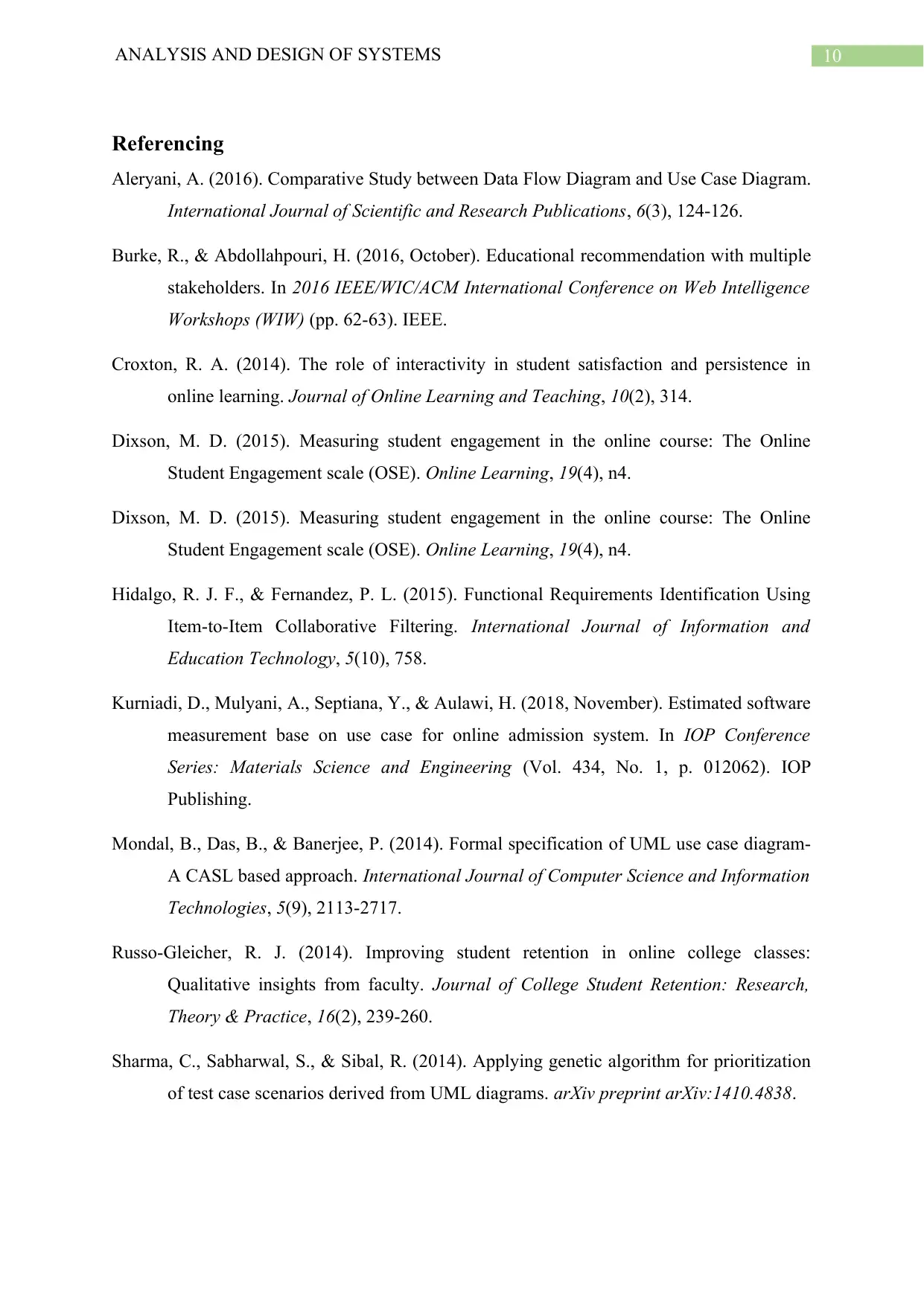
10ANALYSIS AND DESIGN OF SYSTEMS
Referencing
Aleryani, A. (2016). Comparative Study between Data Flow Diagram and Use Case Diagram.
International Journal of Scientific and Research Publications, 6(3), 124-126.
Burke, R., & Abdollahpouri, H. (2016, October). Educational recommendation with multiple
stakeholders. In 2016 IEEE/WIC/ACM International Conference on Web Intelligence
Workshops (WIW) (pp. 62-63). IEEE.
Croxton, R. A. (2014). The role of interactivity in student satisfaction and persistence in
online learning. Journal of Online Learning and Teaching, 10(2), 314.
Dixson, M. D. (2015). Measuring student engagement in the online course: The Online
Student Engagement scale (OSE). Online Learning, 19(4), n4.
Dixson, M. D. (2015). Measuring student engagement in the online course: The Online
Student Engagement scale (OSE). Online Learning, 19(4), n4.
Hidalgo, R. J. F., & Fernandez, P. L. (2015). Functional Requirements Identification Using
Item-to-Item Collaborative Filtering. International Journal of Information and
Education Technology, 5(10), 758.
Kurniadi, D., Mulyani, A., Septiana, Y., & Aulawi, H. (2018, November). Estimated software
measurement base on use case for online admission system. In IOP Conference
Series: Materials Science and Engineering (Vol. 434, No. 1, p. 012062). IOP
Publishing.
Mondal, B., Das, B., & Banerjee, P. (2014). Formal specification of UML use case diagram-
A CASL based approach. International Journal of Computer Science and Information
Technologies, 5(9), 2113-2717.
Russo-Gleicher, R. J. (2014). Improving student retention in online college classes:
Qualitative insights from faculty. Journal of College Student Retention: Research,
Theory & Practice, 16(2), 239-260.
Sharma, C., Sabharwal, S., & Sibal, R. (2014). Applying genetic algorithm for prioritization
of test case scenarios derived from UML diagrams. arXiv preprint arXiv:1410.4838.
Referencing
Aleryani, A. (2016). Comparative Study between Data Flow Diagram and Use Case Diagram.
International Journal of Scientific and Research Publications, 6(3), 124-126.
Burke, R., & Abdollahpouri, H. (2016, October). Educational recommendation with multiple
stakeholders. In 2016 IEEE/WIC/ACM International Conference on Web Intelligence
Workshops (WIW) (pp. 62-63). IEEE.
Croxton, R. A. (2014). The role of interactivity in student satisfaction and persistence in
online learning. Journal of Online Learning and Teaching, 10(2), 314.
Dixson, M. D. (2015). Measuring student engagement in the online course: The Online
Student Engagement scale (OSE). Online Learning, 19(4), n4.
Dixson, M. D. (2015). Measuring student engagement in the online course: The Online
Student Engagement scale (OSE). Online Learning, 19(4), n4.
Hidalgo, R. J. F., & Fernandez, P. L. (2015). Functional Requirements Identification Using
Item-to-Item Collaborative Filtering. International Journal of Information and
Education Technology, 5(10), 758.
Kurniadi, D., Mulyani, A., Septiana, Y., & Aulawi, H. (2018, November). Estimated software
measurement base on use case for online admission system. In IOP Conference
Series: Materials Science and Engineering (Vol. 434, No. 1, p. 012062). IOP
Publishing.
Mondal, B., Das, B., & Banerjee, P. (2014). Formal specification of UML use case diagram-
A CASL based approach. International Journal of Computer Science and Information
Technologies, 5(9), 2113-2717.
Russo-Gleicher, R. J. (2014). Improving student retention in online college classes:
Qualitative insights from faculty. Journal of College Student Retention: Research,
Theory & Practice, 16(2), 239-260.
Sharma, C., Sabharwal, S., & Sibal, R. (2014). Applying genetic algorithm for prioritization
of test case scenarios derived from UML diagrams. arXiv preprint arXiv:1410.4838.
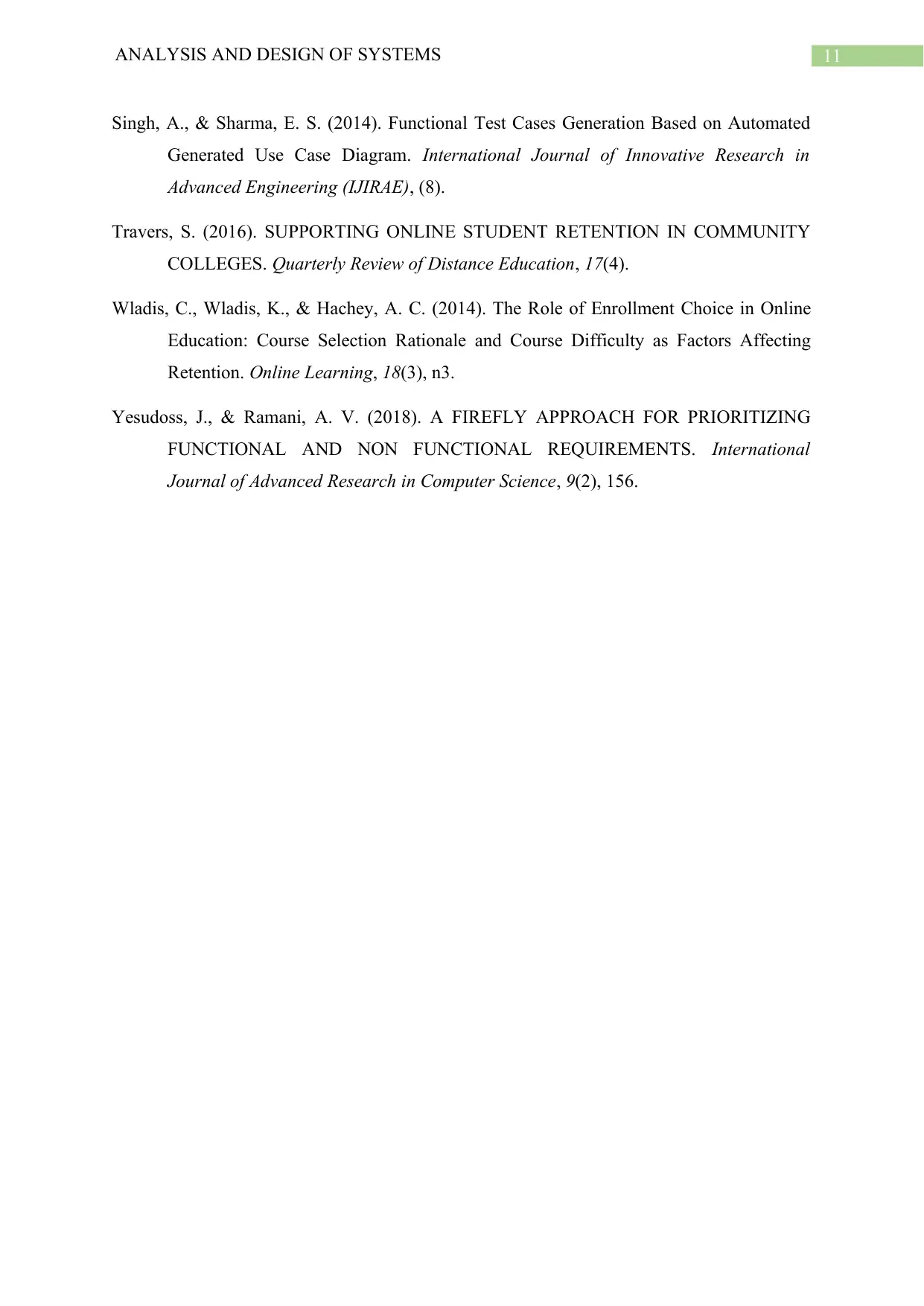
11ANALYSIS AND DESIGN OF SYSTEMS
Singh, A., & Sharma, E. S. (2014). Functional Test Cases Generation Based on Automated
Generated Use Case Diagram. International Journal of Innovative Research in
Advanced Engineering (IJIRAE), (8).
Travers, S. (2016). SUPPORTING ONLINE STUDENT RETENTION IN COMMUNITY
COLLEGES. Quarterly Review of Distance Education, 17(4).
Wladis, C., Wladis, K., & Hachey, A. C. (2014). The Role of Enrollment Choice in Online
Education: Course Selection Rationale and Course Difficulty as Factors Affecting
Retention. Online Learning, 18(3), n3.
Yesudoss, J., & Ramani, A. V. (2018). A FIREFLY APPROACH FOR PRIORITIZING
FUNCTIONAL AND NON FUNCTIONAL REQUIREMENTS. International
Journal of Advanced Research in Computer Science, 9(2), 156.
Singh, A., & Sharma, E. S. (2014). Functional Test Cases Generation Based on Automated
Generated Use Case Diagram. International Journal of Innovative Research in
Advanced Engineering (IJIRAE), (8).
Travers, S. (2016). SUPPORTING ONLINE STUDENT RETENTION IN COMMUNITY
COLLEGES. Quarterly Review of Distance Education, 17(4).
Wladis, C., Wladis, K., & Hachey, A. C. (2014). The Role of Enrollment Choice in Online
Education: Course Selection Rationale and Course Difficulty as Factors Affecting
Retention. Online Learning, 18(3), n3.
Yesudoss, J., & Ramani, A. V. (2018). A FIREFLY APPROACH FOR PRIORITIZING
FUNCTIONAL AND NON FUNCTIONAL REQUIREMENTS. International
Journal of Advanced Research in Computer Science, 9(2), 156.
⊘ This is a preview!⊘
Do you want full access?
Subscribe today to unlock all pages.

Trusted by 1+ million students worldwide
1 out of 12
Related Documents
Your All-in-One AI-Powered Toolkit for Academic Success.
+13062052269
info@desklib.com
Available 24*7 on WhatsApp / Email
![[object Object]](/_next/static/media/star-bottom.7253800d.svg)
Unlock your academic potential
Copyright © 2020–2025 A2Z Services. All Rights Reserved. Developed and managed by ZUCOL.





